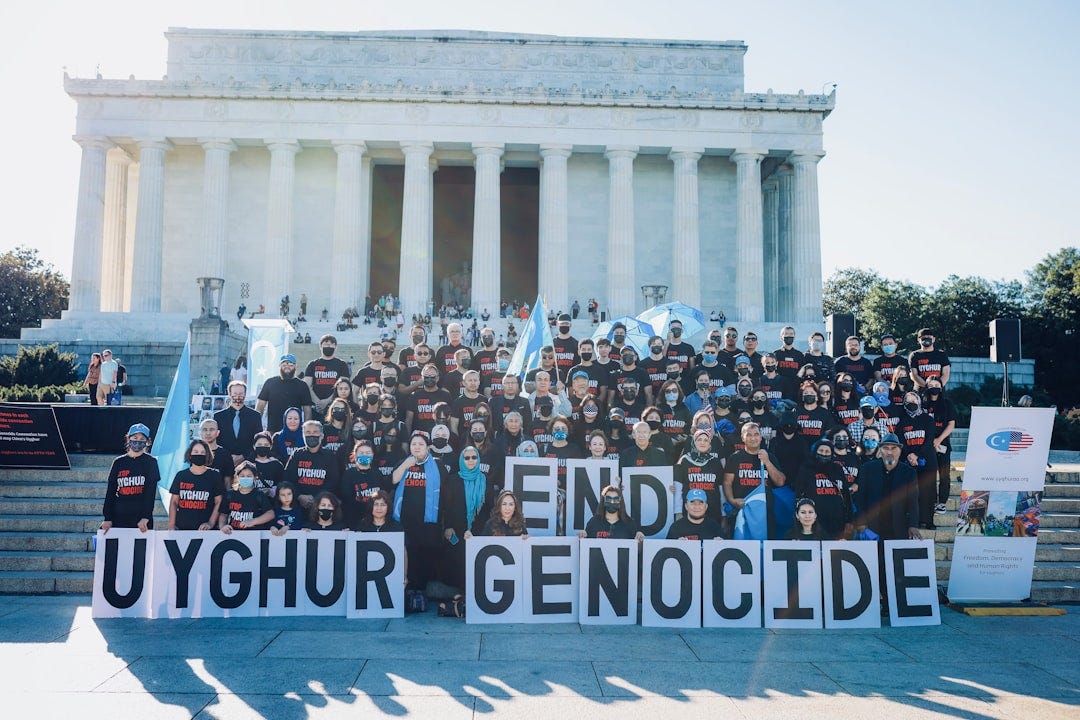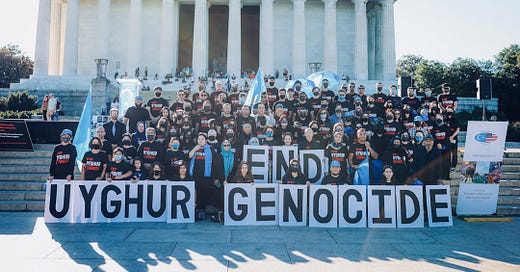The Invisible Crime of Cultural Genocide
We tend to think that 'genocide' only means mass murder...

When we hear the word ‘genocide’, the first thing that comes to mind is probably the Holocaust.
And that’s for good reason. It was a crime against humanity on a scale that the world has never seen before, an atrocity that defies description and understanding. Most people can’t imagine hating other people so much that they would willingly go along with such a thing.
What we tend to forget, though, is that genocide is not defined by mass murder alone. It comes in stages, and it encompasses many different forms of violence, both direct and indirect.
Eradication: The Language of Hate
In my article linked above, I give a full lecture on the definition of genocide as laid out by the UN, and I explain the 10 recognized stages of an active genocide as well.
I wrote it as a response to genocidal language being aimed at the transgender and LGBTQ+ community, but I also highlight instances such as the American and Canadian Japanese Internment Camps, Indigenous Residential Schools and the ongoing Uyghur genocide in China.
Under the definition of genocide, the United Nations makes room for any number of tactics used to violate human rights. One such violation is something referred to as ‘cultural genocide’, which is the erasure of cultural identity, history and heritage from a minority group.
While cultural genocide always crops up in the early stages of all genocides, whether they follow all ten stages or not, it’s important to note that it can also happen on its own.
You don’t need to go through all ten stages to have committed a genocide, you only need to exhibit one of the characteristics outlined under the CPPCG.
Examples of Cultural Genocide
Some of these examples are going to sound jarring. And the reason they’re going to seem jarring is because, if it happened right in front of you, you probably wouldn’t even notice.
In fact, some of them probably have happened around where you live. You probably walk, or drive, right past examples of it every single day.
Cultural genocide is defined as “Any deliberate act committed with the intention of destroying the language, religion or culture of a minority group, such as, for example, prohibiting the use of the group’s language, its schools, or its places of worship.”
There are a few big examples of this, and a few smaller ones. It’s the smaller ones that tend to slip past us. But once I point them out, I’ll bet you can name several examples just from nearby your own home- especially if you live in North America.
I can name quite a few in my city.
But let’s start with the big ones. First and foremost: Removing children from their homes and giving them to other people to raise and educate.
This is something we see happening all around the world. This is partly related to eugenics, removing kids from their families to remove the next generation from marrying within their own culture. Eugenics-based arguments are often used to justify the act of removing children as well, using racial stereotypes to portray women of minority groups as unfit mothers.
But another reason this is done is to remove the children from their culture, and to educate them specifically in the culture of the majority group. The idea is to forcibly assimilate them so as to effectively wipe out the group without the need for bloodshed.
We see this in the Indigenous Residential Schools, the so-called ‘60s Scoop’, and so on. Giving Indigenous children Christian names, punishing them for speaking their own language, and giving them an education that demonized their families and culture and sanitized the horrors of colonial rule.
They also forcibly indoctrinated children into Catholicism and tried to stamp out any form of belief in their traditional religious practices.
We saw another example of this during the more recent incidents at the United States and Mexico border under the Trump Administration. I’m sure we all heard stories about children being forcibly separated from their parents and kept in detention centers.
Many of these families remained split apart for quite a while, with authorities struggling to track down deported parents of migrant children still being held within the U.S. The policy of keeping children detained separately from their parents was intended to act as a scare tactic, meant to dissuade people from attempting the crossing into the United States.
Needless to say, traumatizing people seeking asylum and leaving children in a highly dangerous situation is appalling.
If you want to know how traumatic and abusive these detention centers can be, here’s a report compiled by multiple watchdog organizations such as the ACLU, Human Rights Watch, and the National Immigrant Justice Center. I highly recommend reading it.
Other examples of cultural genocide can include destruction of sacred sites or the theft of historical artifacts. The Nazi regime was notorious for this, as were the founders of the British colonies.
Even today, countries such as Egypt and India are still fighting to have important archaeological finds returned after being removed and sold to the British Museum, which has been called out for owning and displaying cultural objects that were stolen by the British Empire.
Another major example of cultural genocide comes in the form of place names. And here is where we get into the weeds.
If you live in North America, you live on land that was once inhabited by the Indigenous peoples of the continent. You live on land that was colonized by European settlers, mostly the British Empire. So, tell me.
What is the name of the town you live in?
How about the local landmarks? The rivers, the mountains, the forests. What are their names? I ask this because, more than likely, they have multiple names. In several languages.
But I’m willing to bet you only know the English ones, right? Possibly French, depending on where you are. And on the maps, on your GPS, when you look up the place on Google, do you get the original Indigenous language names? Wikipedia might have the original name, listed after the English. If you’re lucky.
Now, this isn’t the case across the board. There are plenty of town names and place names in my country of Canada, for example, that are still named in the language of the original inhabitants. Ottawa, for example, or Musquodoboit.
But we have more than our fair share of names that were changed by the British and French settlers. The St. John River that stretches from the State of Maine into New Brunswick, that used to be the Wolastoq.
This has happened everywhere that European settlers have colonized. South Africa. Jamaica. Hawaii. American Samoa. Haiti. Hell- the Mayan people of South America were nearly eradicated, and their language and histories damn near obliterated by Spanish colonizers.
Go anywhere in historically colonized or invaded lands and tell me how many locations are named for the colonizers who ‘discovered’ them, rather than by the people that were there first.
Talk to an Irish, Welsh, or Scottish person about the history of their language under British occupation. There is a reason that Cymraeg, Gaeilge and Scots Gaelic are having a resurgence now.
Removing or replacing the names of places and individuals and substituting your own language, that is a textbook form of cultural genocide. It can be as simple as an invading army changing the names on street signs and town squares when they capture a city.
We’ve seen examples of that last one happening in Ukraine during Russia’s invasion.
Cultural Appropriation is a Problem
Part of the problem that arises from this is the issue of appropriation.
If you’ve ever seen cheap little mass-produced dreamcatchers at the Dollar Store or seen those tacky old ‘Indian’ costumes in an American or Canadian Halloween display, you’ve seen this in action.
Dreamcatchers, traditional headdresses, cheap plastic beads and fake feathers- we’ve seen these elements sold for profit since we were kids.
Do you know anything about their real history at all? Do you know anything about the context, or the purpose of the objects as used by the Indigenous groups they were stolen from?
How about White Sage? Indigenous cultures of North America have used it for centuries, if not thousands of years, as part of their religious ceremonies.
These days, the plant is almost extinct in the wild due to overharvesting, as a result of uneducated people who want to perform a bastardized version of Smudging without knowing anything about the culture it comes from.
Imagine watching this happen to your culture. Elements of your religion and beliefs being sold, chopped up and misrepresented as a souvenir to people who don’t know anything about it.
And let’s be real- the people buying and selling these things are mostly white.
Imagine your traditional artforms being re-created by people who know nothing about your history of oppression, but sell work based off of your culture for their own profit.
I’m an artist. I’ve had multiple discussions about this issue myself, both with Indigenous people who want more protections for their traditional art, and with white artists who think they should be allowed to create Indigenous-inspired art because it looks cool.
My personal opinion is that if you want to appreciate artwork that’s created by a particular culture, you should reach out to an artist from that particular culture so that your money supports them. But that’s just me.
There’s a discussion to be had there about the difference between an open culture versus a closed one, too. Cultures that have traditionally expanded outward into the world tend to be more open to newcomers and are often less restrictive about who can practice within their culture and religion.
Cultures that have faced historical oppression, however, tend to be more insular for the sake of self-defense. Their cultures have nearly been wiped out by invaders, and due to previous and ongoing cultural genocide, they tend to dislike seeing outsiders appropriating elements of their art and religion.
Native Americans, First Nations and Sami peoples are examples of more closed cultures- although, it’s important to note that I can’t speak for them. I do have Mi’kmaq ancestry, but it’s a few generations back and I was raised outside of the Nation in question. I’m very much a white woman, so it’s not my culture to gatekeep.
If you’re unsure about whether or not the art or tradition you want to explore is part of a closed culture, it isn’t hard to find out. You can simply ask. Be polite, and respectful, and be gracious if the answer you get is ‘no’.
Just don’t be an insensitive dick. It’s that simple.
Those Who Do Not Learn from the Past…
The world we live in today has been shaped by cultural genocide. Entire countries and ethnic groups, their languages and traditions, they’ve been erased from the history books.
If we want to fight for equality, if we want to live in a world that recognizes the humanity and the value of every person, we need to be aware of what has already happened.
Learning about the crimes of the past is the only way to be prepared for the next tragedy, and to recognize the signs of it before it happens again.
Be aware, and be ready. And always remember, solidarity wins.


